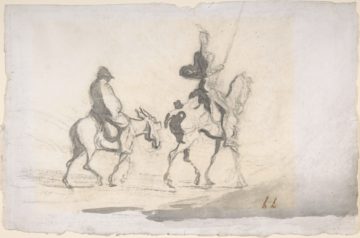Jeffrey Herlihy-Mera in Public Books:
 Don Quixote is the Saturday Night Live of the Spanish Inquisition. Cervantes roasts everybody, including the Catholic Church and even the reader. This magnum opus—called by many the first Western novel—is really a book about reading: Carlos Fuentes famously said of Quixote: “Su lectura es su locura.” [“His reading is his madness.”] Quixote reads too much (if that’s possible) and wants to become the literary heroes of his books. But just who are those heroes?
Don Quixote is the Saturday Night Live of the Spanish Inquisition. Cervantes roasts everybody, including the Catholic Church and even the reader. This magnum opus—called by many the first Western novel—is really a book about reading: Carlos Fuentes famously said of Quixote: “Su lectura es su locura.” [“His reading is his madness.”] Quixote reads too much (if that’s possible) and wants to become the literary heroes of his books. But just who are those heroes?
Quixote lauds Amadís de Gaula, El Cid, and Roland, among others. But he also venerates figures—ostensibly enemies of Christian Spain—from the Qur’an as well as Spaniards who were exiled for Muslim ancestry.
The Reconquest described in Quixote’s books ended a century before, in 1492, when the final independent Muslim kingdom in Western Europe (in Granada) was expelled. By Quixote’s day, there were apparently no more Moors in Iberia. Still, Quixote lights out in search of heroic battles to sanctify Spain, in the guise of El Cid. (The historical Cid—Rodrigo Díaz de Vivar—served many years on the court of the Taifa de Saraqusta, but, in the epic poem about his exploits, he fights exclusively against Muslims.)
On his great quest, Quixote finds only madness and Manchegan windmills, mistaking the latter for giants (i.e., Moors). Between the lines, however, Cervantes concealed a story that literary critics are only beginning to resolve. It’s a biting satire of the Catholic Church—but also a nostalgic and painful account of the systematic destruction of Islamic culture in Spain.
More here.
